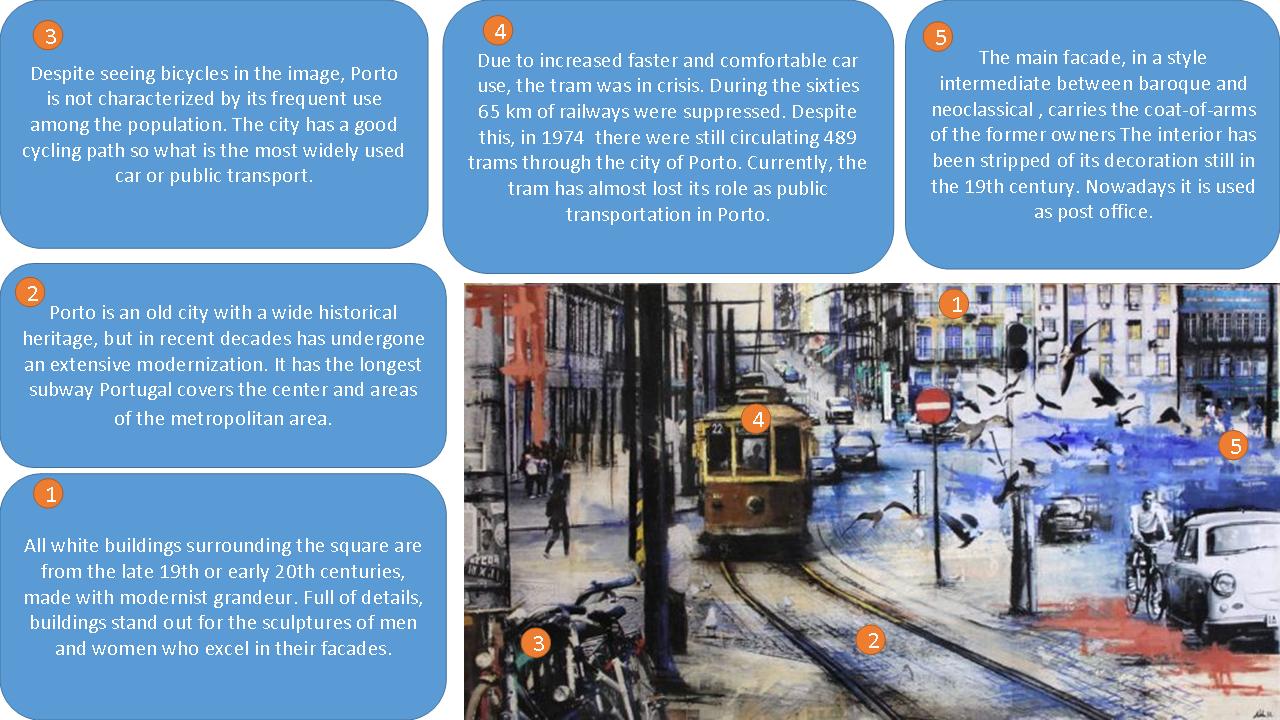This picture represents the tram of Porto. It is made with pencil on wood in 2010 by Udane Juaristi (Azkoitia, 1985). She is a painter who is licensed in Fine Arts specializing in painting and studies in l´École Nationale de Beaux Arts of Paris. This picture is part of a collection entitled “cars and trams” and has been exposed in many cities of Spain, above all in the Basque Country. The picture is not dated, but we can know that is a modern painting according to the style of the cars and the clothing of the people. We can see as the principal element the tram, specifically the number 22, what has allowed us to know the area of the city. The picture was taken near St Catarina Street, that is the main shopping area of the city; this is pedestrian street and is located at the top of the city. As a curiosity in the picture we can see some seagulls because in Porto there is a big colony of urban seagulls.
Porto is one of the most important cities in Portugal, although it is not a very big city (237.559 habitants). It was founded in 1123 and it is situated in the North of Portugal, on the right bank of the Duero river. Actually, Porto has centralized its urban structure around the Duero river. Apart from this center the city has many slopes, caused by the difference in height between the Duero river and the highest points of the city which is around 75 meters. As many other European cities, Porto is an old town with a wide historical heritage, but in recent decades has undergone an extensive modernization. It has the longest subway netweork in Portugal to cover the whole metropolitan area, from the city center to outskirst. Also, the Sá Carneiro International Airport has recently been expanded to a capacity of 16 million passengers a year.
In Porto, old trams have been restored and only three lines are working nowadays. The line 22 circulates between the Carso area and the area of Batalha, where the Batalha Square and São João theatre are, and it also passes along the Avenue of the Allies and very near of Santa Catarina street.
In the 19th century Porto had an economic and political decline in the city with only some service activities, such as shipping and maritime trade. But in the decade of 1890 and the beginning of the 20th century the port of Leixoes boosted an economic growth in Porto coinciding with industrialization and the arrival of the Republic. A symbol of this era is the construction of the Avenue of the Allies. The urban space of Porto started to be developed in the late 19th century. A new Central Business District was created and an intense process of functions specialization was set on each urban area. The constructions made in the early 20th century broke with the traditional ambience of the city and consolidated modernity. The railway station of São Bento was an example of new communications in Porto, that converge several roads and railway lines, which also contributed to turn the city into the main shopping center in the Northern region of Portugal. Despite the progressive outsourcing center, industrial activity continues to be of great importance to the work in its industrial belt full of factories for textiles, footwear, furniture, ceramics, metalwork, jewelry and other manufacturing activities, some also craft.
In 1919, as a response of the Lisbon attempt of independence, conducted by Paiva Couceiros, Porto became tentatively capital of Northern Portugal. The immediate Republican reaction ended the uprising. The Salazar dictatorship, which lasted until the Carnation Revolution of 1974, much improved infrastructure, highlighting the construction Porto Arrábida Bridge in 1963. In 2001 Porto was, next to Rotterdam, cultural capital of Europe and, for such an event, the striking auditorium «Casa da Música» was built in Boavista, symbol of the capital. Today Porto, economically speaking, is lagging behind Lisbon, while still maintaining its reputation for working, open and welcoming city.
César Martín López

